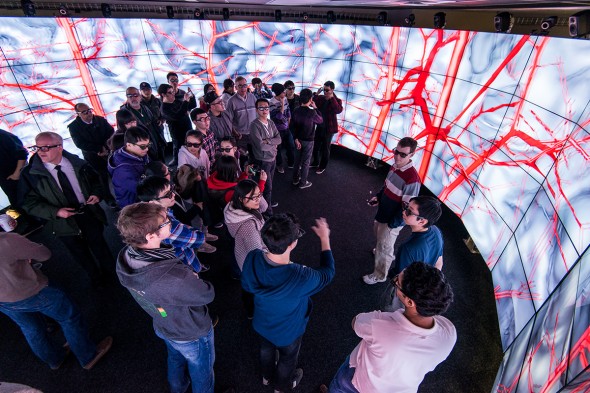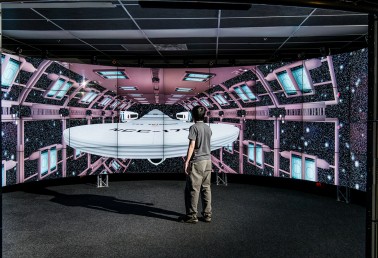Step into CAVE2 virtual world

Thomas Marrinan, EVL research assistant and computer science Ph.D. candidate, guides a tour at a recent open house. Photo: Lance Long
“We love science fiction, and we just want to live in the science fiction world,” said computer scientist Jason Leigh.
And inside the Electronic Visualization Lab’s CAVE2, anyone can enter a virtual world.
The EVL’s virtual reality environment in the College of Engineering lets people navigate through the human brain or roam through the holodeck of the Star Trek Enterprise with the help of 3D glasses.
This imposing virtual world stands 8 feet tall and 24 feet in diameter. The environment wraps 320 degrees around the user, offering a dream-like sense of infinite space that is never physically there. The system rivals 20/20 vision, consisting of 72 near-seamless passive stereo off-axis optimized 3D LCD panels that display information at 37 megapixels in 3D, or 74 megapixels in 2D.
Students and employees toured the space at an open house Feb. 20. More open houses are set from 3 to 6 p.m. April 3 and 24 in the Engineering Research Facility. Space is limited; register online.
After three years spent searching for funding, then another year of research, the time was right for the new virtual-reality environment to come to life this fall, said Leigh, EVL director and associate professor of computer science.
The EVL developed the first CAVE virtual reality system in 1992 and the OptIPortal scalable-resolution display wall in 2004.
In 2010 researchers started building CAVE2, the second-generation virtual reality environment, with a grant from the National Science Foundation.
“We waited, and we did some more research, and finally, there was this sweet spot in time where the technology was just good enough to do it,” Leigh said. “And that’s when we decided we had to build this new CAVE.”
There are many uses for the new technology. Astronomy classes at UIC are scheduled to visit the CAVE2 this fall to use the environment as a planetarium. There are plans to take a model of Chicago, then map data such as crime rates and police station locations over the city.
“What good is collecting the data if you’re not going to make sense of it”? Leigh said. “So this is a really good opportunity to do this, by using the CAVE. If you pool more of your resources here, what might be the impact on crime down the road?”

Graduate student Arthur Nishimoto created the Star Trek holodeck in the EVL’s CAVE2 system. Photo: Lance Long
Leigh, co-creator of CAVE2, said the project was a true campus collaboration.
“Every nut and bolt that was screwed on here was actually put together by undergraduates and graduate students, so a whole lot is owed to their effort,” Leigh said.
“It’s not like some commercial company came in and screwed it all in. Every box, for all 36 computers that came from the loading dock, was lifted by students and faculty.
“That’s what I’m really proud of.”
Arthur Nishimoto, a graduate student in computer science, has proven that it’s not all business in the lab. He created the ultimate science-fiction world, a 1:1 scale model of the Star Trek Enterprise holodeck.
The model allows you to view the entire ship, fly beneath the bridge and explore the engine room — a dream realized for Star Trek and science-fiction fans alike.
“In my lifetime I will never experience this, but with the CAVE you can,” Leigh said.
With the use of a small, handheld controller called a “wand” and 3D glasses with motion-sensor tracking, data is visualized at your fingertips.
“It turned out better than we had even imagined,” Leigh said.
